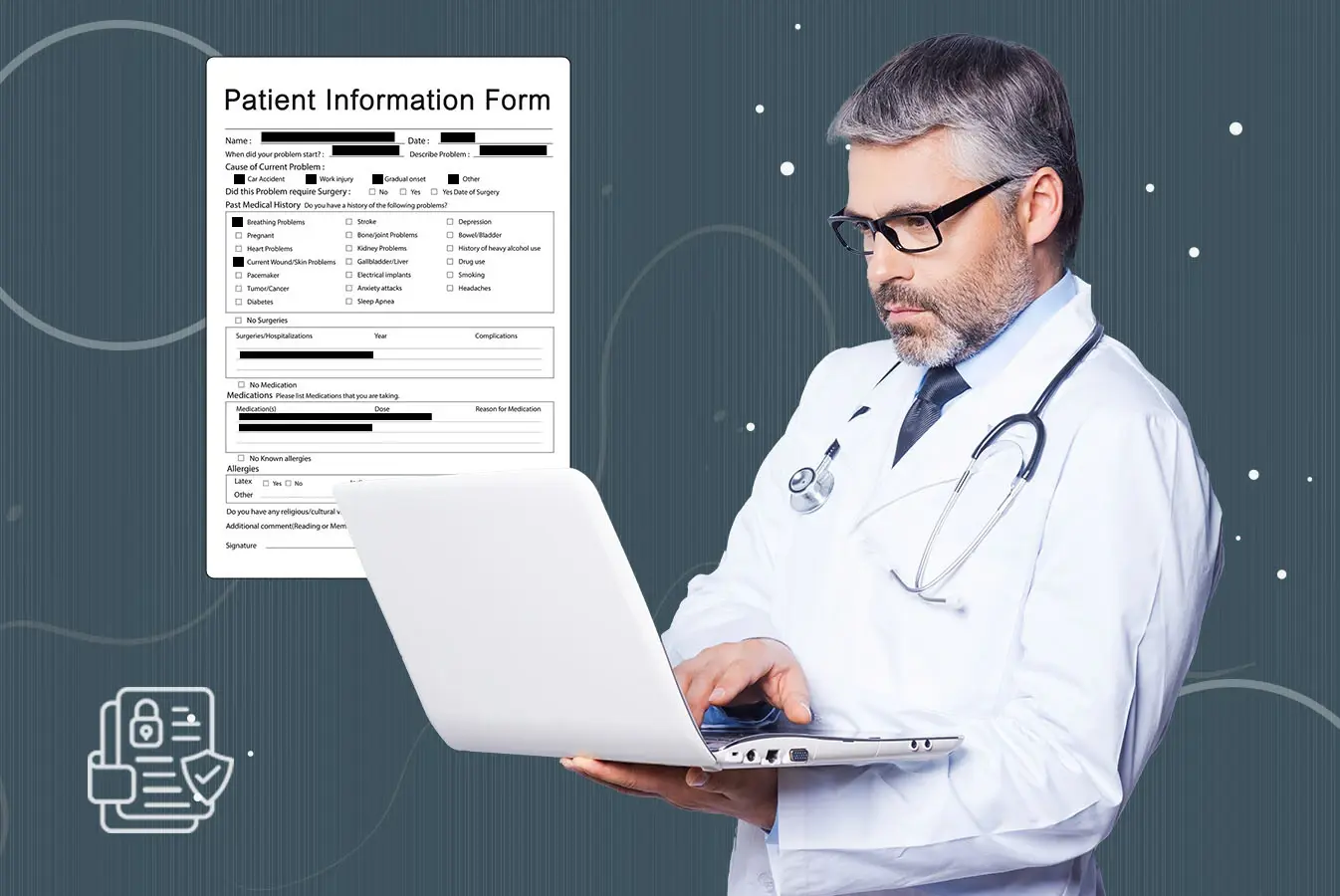Reducing Data Breach Risk in the Financial Sector with Redaction Tools
by Umer Ahmed on December 22,2023

Since December 2022, insurance companies and financial institutions have been victims of more than 567 recent data breaches, resulting in over 254 million leaked records. This is why the need for Redaction tools is now more than ever!
Because besides the financial burden that follows, data breaches lead to legal battles, compliance issues, and tanked trust and reputation.
This is due to the loss of sensitive data, which includes confidential information that can't be made public. Instances of such data include financial reports, customer details, transaction records, customer credentials, social security numbers, and more.
In finance, trust relies on securing sensitive data — vital for financial stability, compliance, and client confidence.
That is why redaction tools have become a frontline defense against breaches, selectively obscuring or removing sensitive information.
Keep reading for in-depth information, or jump right to our 7-day free trial for a hands-on experience.
Why should Financial Institutions use Redaction Tools to Safeguard Against Data Breaches?
In 2023, until November's end, there were 1,404 data breaches, leading to 519,111,354 records being leaked. Since financial gains back most breaches, the financial industry was among the most targeted sectors.
Also, several high-profile cases point towards the seriousness of the matter; for instance, in May of 2019, the First American Financial Corp exposed 885 million of its records, which contained real estate transactions.
Likewise, in October 2014, 83 million of JPMorgan Chase's accounts were hacked, and the fraudsters extracted customers' contact information.
However, most of the consequences of data breach or hacks can be mitigated with the help of a redaction tool.
Typically, these cases result because passwords are weak, multifactor authentication is not applied, or a malware-ridden link is opened.
Cyber breaches have devastating effects on financial establishments and their customer base. When a data breach occurs, the stock price of the establishment goes down, especially for public limited companies.
They suffer an average decline of 7.5% in the stock price, and it can take over a month to recapture their stock value.
Besides that, attackers may make the stolen info public on the dark web, and it can be used for various fraudulent activities like credit card fraud, identity theft, etc.
One such case was the ransomware attack and data breach of ION Group, where the group threatened to publish stolen data.
Furthermore, such organizations can also face lawsuits from victims, reductions in credit ratings, and loss of competitive advantage.
This is where redactor tools come in to censor or remove sensitive information that can be used for malicious activities. Upon finding the vulnerable information, we can make it unidentifiable or altogether remove it with redaction.
How do Redaction Tools ensure Data Security?
In data security, redaction refers to selectively obscuring or removing sensitive information from a document, file, or other forms of media to protect confidentiality and prevent unauthorized access.
Redaction is commonly employed to safeguard personally identifiable information (PII), financial details, legal content, or any other sensitive data that, if exposed, could lead to privacy breaches, compliance violations, etc.
Redaction aims to minimize the risk of data breaches, adhere to privacy regulations, and uphold the confidentiality of information in various contexts, such as legal proceedings, financial transactions, or sensitive corporate communications.
Traditional vs. Modern Redaction Tools and Methods
The following are the key differences between modern and conventional redaction tools.
Traditional Redaction Tools
Here are some factoids about traditional redaction tools:
- A manual process with physical redaction
- Limited efficiency, especially for large volumes
- Paper-based, not ideal for digital documents
- Risk of information residue and human error
Modern Redaction Tools
Here are some factoids about Modern Redaction Tools:
- Digital automation for faster, more accurate redaction.
- Advanced search and pattern recognition.
- Collaboration and version control for teamwork.
- Secure handling of digital documents.
- Audit trails for compliance.
- Integration of machine learning for improved accuracy.
What are the Benefits of Redaction Tools for Financial Institutions?
Redaction is a crucial element for financial institutions. It protects sensitive information mainly because of ensuring regulatory and compliance requirements.
Redaction tools systematically remove Personally Identifiable Information and other sensitive information to prevent disclosure and unauthorized access to confidential data in financial institutions.
Here are how redaction tools benefit the financial sector:
Securing Personal Identifiable Information
Financial institutions have access to a considerable amount of PII information, including addresses, social security numbers, names, and other information. Redaction can safeguard this data and prevent identity theft of client and customer data.
Securing Financial Account Details from Data Breaches
Besides PII, financial firms also hold account numbers, transaction details, and other confidential details that can be exploited and used for malicious purposes. They must ensure PII privacy and security.
Redacted videos, audio, images, and documents protect these details and prevent malicious entities from accessing such data.
Securing Transaction History
Transactions are an inherited part of financial firms. However, this data also shows trends and spending behavior. Redaction can help preserve customer privacy and hide transaction patterns.
Securing Holdings and Investment Strategies
Investment banks hold proprietary investment strategies and tactics that deal with client-holding information.
By redacting, firms can protect intellectual property and prevent competitors from accessing insights.
Preventing Insider Threats
Insider threats are also a significant risk factor in organizations where employees can access large databases.
The redacting procedure limits access to authorized personnel only. As a result, firms can mitigate internal data breaches.
Litigations and Legal Documentation Redaction
Financial establishments often deal with sharing sensitive information in legal documents. Here, redaction protects confidential information that is unnecessary during legal proceedings.
How do Financial Institutions ensure Compliance with Redaction Tools?
Redacted videos, audio, documents, and images must comply with regulatory guidelines to protect sensitive information in various documents.
Here is how redaction tools help comply with specific regulations and standards.
General Data Protection Regulation (GDPR) Compliance
GDPR compliance requires businesses to comply with European data protection and privacy laws. Redaction can help companies comply with GDPR, removing PII in visual documents.
The Health Insurance Portability and Accountability Act (HIPAA)
HIPAA compliance requires businesses working with or providing services to healthcare establishments to protect healthcare-related information in any document.
Redacting data is essential in healthcare finance to conceal patient data confidentiality and maintain compliance with HIPAA guidelines.
The Payment Card Industry Data Security Standard (PCI DSS)
Financial firms must comply with PCI DSS, which sets security and compliance requirements for establishments that deal with credit card transactions.
Redaction tools help financial firms comply with PCI DSS by redacting sensitive information and credit card numbers in video and other documents.
The U.S. Securities and Exchange Commission (SEC)
SEC regulates monetary and financial institutions to protect market integrity and protect investor's data.
With redaction, firms can comply with SEC regulations by redacting investment strategies, propriety financial data, and client interactions.
Preserving the Reputation of Financial Firms with Redaction Tools
With the help of redaction, organizations can maintain the confidentiality of the data and foster trust. Remember, clients prefer others over you if there is a lack of trust, resulting in lesser revenue.
Redaction tools preserve customer privacy, so the extracted data will have no sensitive info even if there is a breach. As a result, organizations can reduce potential damage to the database and reputation.
This proactive approach builds trust as customers and clients appreciate the extra effort put towards keeping them safe.
In addition, being compliant with data protection laws builds confidence among investors, customers, and regulatory entities.
Industry giants like JP Morgan Chase encourage and use redaction via advanced ML to censor PII, NPI, and PCI data and safeguard non-public information.
Potential Challenges in Implementing Redaction Tools
The redaction procedure can be technical and may have to be tailored for different organizations, depending on the type of work.
Most financial firms manage ample amounts of data that must be swiftly redacted without errors to address all potential privacy challenges.
However, there are certain complexities involved:
Dealing in Large Volume and Scale
Companies deal with many names, addresses, SSNs, credit card numbers, and other information. Coping with such substantial amounts can be tricky, especially when there is no margin for error.
Meeting Regulations and Compliances
Data regulations and privacy acts like GDPR, HIPAA, and FERPA impose strict protection laws, and financial firms collect extensive consumer data for KYC (know your customers) requirements.
As a result, they must perform redaction in a manner that complies with such regulations when working with enormous amounts of data.
Working with Accuracy and Precision
Precise redaction without over-redacting or data leakage is a complex task that can be challenging.
Even the smallest of occurrences neglected can pose a risk to a business and its clients, sometimes leading to significant financial losses.
VIDIZMO Redactor – One of the best Redaction Tools on the Market!
Financial Institutions need a robust and reliable redaction solution for their needs, and VIDIZMO Redactor is right up their alley! Its features, compliances, and usability allow users to process enormous amounts of data precisely.
The following are the core features that use AI-backed technologies for redaction purposes.
- It can conduct video redaction by automatically detecting faces, people, and more in video files.
- The image redaction feature will allow financial institutions to redact PII, license numbers, and other valuable information.
- The audio redaction feature redacts sensitive information from audio files by using transcripts. This feature also empowers financial institutions and others to redact spoken words that include PII details and other confidential information.
- Document redaction empowers organizations to redact names, SSNs, emails, phone numbers, addresses, and more in OCR and non-OCR documents.
With VIDIZMO's redactor tool, organizations can have AI-powered redaction capabilities to remove sensitive and irrelevant information from documents, videos, audio, and images.
In the event of a data breach, the data will have redacted files and no confidential information.
Moreover, it will allow organizations to protect themselves from internal data breaches via Role-based access control, allowing access to only those authorized to view, amend, or share.
Trust in the finance sector relies on secure data handling, making redaction tools crucial for stability and client confidence.
In the face of ongoing data breach challenges, redaction, including videos, proves focal in mitigating risks and safeguarding sensitive information.
Frequently Asked Questions (FAQs)
What is redacted face?
Redacted face means to blur, remove, or blackout faces from images and videos. This way, PII information can be removed from any file.
Who uses redaction?
Every industry and market can use redaction to safeguard sensitive information and comply with privacy laws.
Is redaction the same as encryption?
No, redaction and encryption are distinct concepts. Redaction involves selectively removing or obscuring sensitive information from a document. At the same time, encryption is converting data into a coded form to prevent unauthorized access, but it doesn't selectively hide specific information within a document.
What is a data breach?
A data breach is the unauthorized access or release of sensitive information, like personal or financial data, often resulting in privacy violations. Data breaches examples include cyberattacks, stolen information, ransomware attacks, and more.
Why are data breaches a problem?
Data breaches are problematic because they can lead to identity theft, financial fraud, and reputational damage. They can cause harm to individuals and organizations.
Jump to
- Why should Financial Institutions use Redaction Tools to Safeguard Against Data Breaches?
- How do Redaction Tools ensure Data Security?
- What are the Benefits of Redaction Tools for Financial Institutions?
- How do Financial Institutions ensure Compliance with Redaction Tools?
- Preserving the Reputation of Financial Firms with Redaction Tools
- Potential Challenges in Implementing Redaction Tools
- VIDIZMO Redactor – One of the best Redaction Tools on the Market!
- Frequently Asked Questions (FAQs)
You May Also Like
These Related Stories

How AI-Based Redaction Software Helps Resolve Data Privacy Challenges

Keeping Patient Confidentiality in Healthcare with Redaction Software




No Comments Yet
Let us know what you think